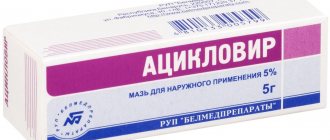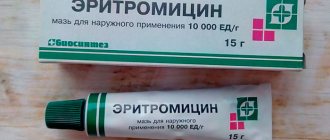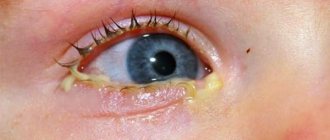132
Author of the article
Tsareva Elena Vladimirovna
Reading time: 9 minutes
A A
Tetracycline ointment is a popular drug in the treatment of eye diseases, including conjunctivitis. Due to the effectiveness of the product, it is approved by most ophthalmologists. The ointment can be used for adults and children over 8 years of age.
- Description and composition of the drug
- Medicinal properties and principle of action
- Indications
- Contraindications
- Reaction and side effects
- Preparation
- Features of use in adults
- Use in children
- For different types of illness
- Price and analogues
- Conclusion
Description and composition of the drug
Tetracycline ointment belongs to the group of antibiotics. The main active component of the composition is tetracycline hydrochloride (0.03 per 1 gram). Additional components are also present: paraffin, petroleum jelly, ceresin, sodium sulfite, anhydrous lanolin.
The medication has a wide list of indications, including it is used to treat conjunctivitis. The drug inhibits the proliferation of pathogenic microorganisms at the protein level. By eliminating bacteria from the mucous membrane of the eye, it helps relieve itching, lacrimation, and redness. The ointment acts gently and rarely provokes adverse reactions.
Tetracycline ointment is effective against the following microorganisms:
- streptococcus;
- staphylococcus;
- Pneumococcus;
- mycoplasma;
- gonococcus;
- chlamydia;
- salmonella
- clostridia;
- shigella;
- coli.
Expert opinion
Ermolaeva Tatyana Borisovna
Ophthalmologist of the highest category, Candidate of Medical Sciences
The drug is ineffective for viral conjunctivitis. It also does not affect all types of fungi.
Medicinal properties and principle of action
First of all, tetracycline prevents the growth and reproduction of pathogenic microorganisms that cause conjunctivitis. Secondly, it acts as a bactericidal drug. In contact with microorganisms, the active substance enters their cells and disrupts the processes of synthesis of protein compounds that they require for life and reproduction. As a result, bacteria lose their ability to reproduce and die. Thus, the product demonstrates high results in the treatment of bacterial conjunctivitis . It helps both suppress the activity of pathogens and relieve unpleasant symptoms.
The medication acts locally, is not absorbed into the eye tissue and does not penetrate the systemic bloodstream. Because of this, it is not toxic and can be used to treat children.
Indications
Tetracycline ointment has the following indications for use:
- conjunctivitis and blepharitis;
- trophic ulcers;
- trachoma;
- the presence of ulcerations on the skin of the eyelids;
- diseases of the mucous sac;
- diseases of the cornea.
Expert opinion
Ermolaeva Tatyana Borisovna
Ophthalmologist of the highest category, Candidate of Medical Sciences
The product can also be used to prevent ophthalmological complications.
The effect of the ointment: what it treats and what it doesn’t treat
The main active ingredient of tetracycline ointment is tetracycline hydrochloride. It is a broad-spectrum antibiotic. Therefore, the ointment itself is used for various bacterial and purulent infections:
- staphylococci;
- streptococci;
- gonococci;
- coli;
- whooping cough stick;
- dysentery bacillus.
- enterobacteria;
- salmonella;
- shigella;
The range of applications of tetracyclines is quite wide. The exception is a number of infections against which tetracycline is not effective :
- Pseudomonas aeruginosa, serrations, bacteroides.
- Viral infections . Antibiotics do not have any effect on viruses. Therefore, tetracycline ointment for herpes is not used due to ineffectiveness. For ophthalmoherpes (inflammation of the cornea, which is caused by the herpes simplex virus - usually labial (oral)) - treatment is carried out with antiviral drugs. Antibacterial agents become necessary if bacterial contamination occurs against the background of a viral infection. Such addition of another type of infection can be treated with tetracycline ointment.
- Fungal infections - antibacterial drugs not only do not treat fungal diseases, but even provoke their appearance.
Varieties: 1% and 3%
Tetracycline ointment has a characteristic yellow color and odor. The ointment is based on petroleum jelly and paraffin (formative components to which an antibiotic is added). The effect of the drug is explained by the so-called bacteriostatic effect. It stops the growth and development of pathogenic bacteria (which ones are listed above in the previous section).
The instructions for using tetracycline eye ointment indicate two forms of the drug, which differ in the content of the active substance. This is an ointment of 1% and 3%. The concentration of the antibacterial component in them is 1 g or 3 g per 100 g of ointment, respectively. This 1% or 3% has the main therapeutic effect.
The difference in concentrations of the active substance makes it possible to treat infections of different localizations with the ointment - on the skin and mucous membranes. A composition with a lower tetracycline content is used in ophthalmology. With great – in the treatment of skin inflammations :
- 1 percent tetracycline ointment - eye . It is used to treat ophthalmic inflammations - conjunctivitis, blepharitis (inflammation of the eyelids), keratitis (inflammation of the eye cornea). Tetracycline ointment 1% concentration cures the most complex and extensive conjunctivitis and other eye infections.
- Tetracycline ointment 3% - used in the treatment of various purulent skin infections . Indications for the use of tetracycline ointment 3% are boils, trophic purulent ulcers, acne, ulcers of any origin, streptoderma, phlegmon, infectious dermatitis (inflammation of the skin against the background of an allergic reaction with the addition of pathogenic bacterial flora).
Reaction and side effects
Side effects are quite rare, and most often they are the result of non-compliance with contraindications or improper use of the drug.
Tetracycline ointment is not toxic and rarely provokes adverse reactions. As a rule, the body tolerates it well. In some cases, the following negative effects are possible:
- nausea and vomiting;
- loss of appetite;
- manifestations of allergies: rash, swelling, burning;
- photophobia.
Features of use in adults
The ointment must be placed behind the lower eyelid, gently pulling it back and pressing on the tube. Hands must be clean. The pupil rolls behind the upper eyelid. Make sure that the edge of the tube does not come into contact with the membrane of the eye. To ensure that the drug is evenly distributed, it is recommended to close your eyes for a few seconds after applying it.
Expert opinion
Ermolaeva Tatyana Borisovna
Ophthalmologist of the highest category, Candidate of Medical Sciences
The ointment is not prescribed together with glucocorticosteroids, since their effect can be greatly enhanced by the action of tetracycline, which will lead to side effects.
A glass spatula can also be used for application. It should be treated with antibacterial soap and wiped with sterile gauze. It is better to ask someone to help you with the procedure. Features of use are as follows:
- A small amount of ointment is applied to the shoulder blade. There is no need to take too much so as not to cause sticking or itching of the eyelashes.
- After applying the product, you need to close your eyes for a few seconds and then blink.
- If after this you feel excess drug in the eye, carefully remove it with a cotton pad or napkin.
The ointment is applied to the eye three or four times a day until symptoms are completely eliminated. If the mucous membranes are affected by chlamydia, treatment takes approximately 3 weeks. If the pathology has led to deterioration of vision or changes in the cornea, the patient also needs general antibacterial therapy. For chlamydial conjunctivitis, the product is placed behind the eyelid 2-3 times a day. After completing the course and eliminating unpleasant symptoms, it is recommended to use the drug for another week.
A single dosage is one strip no larger than one centimeter.
One package of ointment is enough for a course of treatment. The medicine can be stored for no more than two months after opening. After applying the ointment, carefully twist the tube. When unopened, the medicine can be stored for three years.
Tetracycline ointment for conjunctivitis
IT IS IMPORTANT TO KNOW! An effective remedy for restoring vision without surgery or doctors, recommended by our readers! ...
Tetracycline ointment is widely used in the treatment of eye diseases. The product is highly effective, which is why it is approved by most ophthalmologists. The drug is especially effective for the inflammatory process of the conjunctiva (mucous membrane of the eye). Tetracycline ointment for conjunctivitis can be prescribed to adults and children over 8 years of age.
Tetracycline ointment is part of the group of antibiotic drugs. 1 gram contains 0.03 grams of tetracycline hydrochloride, the main active ingredient. The drug is actively used not only for the treatment of conjunctivitis, but also in the treatment of acne, eczema, burns and other ailments. The healing effect of the product is to suppress the proliferation of pathogenic microbes at the protein level. By freeing the mucous membrane of the eye from bacteria, the drug relieves redness, itching and tearing. The product has a mild effect, without causing burning, pain, stinging or discomfort in the eyes.
Important! Before you start using the ointment, you should consult a qualified specialist. One percent tetracycline ointment is used to treat eye diseases in adults. The drug must be used immediately after the first signs of the disease are noticed. Among the main symptoms of conjunctivitis are:
- redness of the conjunctiva;
- burning sensation and itching in the eye;
- sticking of eyelids, purulent discharge;
- inflammation, swelling of the eyelids;
- lacrimation and rapid eye fatigue.
Before you start using any eye ointments, you need to wash your face with water at room temperature and thoroughly remove makeup from your face. After washing, you need to dry your face with a napkin, but do not rub it. No creams or other care products should be applied to the skin. If the ointment is put into the eyes directly from the tube, first its edge must be treated with a disinfectant solution and then rinsed with boiled water. With clean, washed hands, carefully pull down the lower eyelid and place a thin strip of tetracycline ointment behind it, pressing on the tube. In this case, the pupil needs to be rolled back behind the upper eyelid. Make sure that the edge of the tube does not touch the eye. To distribute the product evenly along the entire length of the eyelid, close your eye for 5-7 seconds.
If you use a glass spatula for insertion, it must be treated with antibacterial soap and then wiped with sterile gauze. The rules for using a glass spatula are as follows:
- A small amount of the drug should be applied to the shoulder blade, since excess product in the eye can cause itching or sticking of the eyelashes;
- it is better to carry out the procedure using someone else’s help;
- the lower eyelid should be pulled back very carefully, while the eye should look upward;
- after applying the product, you must close your eyes for 7 seconds and then blink;
- If, after blinking, excess medication is felt in the eye, it should be carefully removed with a napkin or cotton pad.
Tetracycline ointment should be applied to the eye three or four times a day until symptoms disappear. In the case when the mucous membranes of the eyes are affected by chlamydia (chlamydial conjunctivitis), treatment of the disease takes about 3 weeks. If the disease has caused blurred vision or led to changes in the cornea, in addition the patient will be given general antibacterial therapy. For chlamydial conjunctivitis, it is recommended to apply tetracycline ointment behind the eyelid twice or thrice a day. After completing the course of treatment and upon recovery, the drug should be used for another 7 days for preventive purposes.
One percent ointment can also be used to treat conjunctivitis in children over 8 years of age. If the child has not reached the age of eight, you should consult a doctor to prescribe appropriate medications. One package of tetracycline ointment is enough for a course of treatment. The drug used in open form should be stored for no more than 2 months. After use, the aluminum tube must be carefully tightened. Unopened medicinal products can be stored for 3 years.
To treat eyes without surgery, our readers successfully use a proven method. Having carefully studied it, we decided to offer it to your attention. Read more…
When treating conjunctivitis with tetracycline ointment, additional agents can be used. For example, Oftagel is used in parallel to prevent dry eyes. The therapeutic effect of Oftagel is to create a protective moisturizing film over the entire surface of the cornea. Oftagel helps reduce irritation, itching and burning in the eye. Instill the product into the affected eye, 1 drop up to 4 times a day. Before using the drug Oftagel, you should carefully study the attached instructions. If allergic reactions to the components of the product occur, you must stop using it. Vidisik eye gel can be used instead of Oftagel.
In addition to tetracycline ointment, the following antibiotic ointments can be used in the treatment of inflammatory eye diseases:
- tobrex;
- colbiocin;
- ofloxacin;
- acyclovir.
Before using any additional products, you should consult your doctor.
Tetracycline ointment for conjunctivitis is not recommended for use in the following cases:
- age less than 8 years;
- pregnancy;
- renal failure;
- liver pathologies;
- decreased white blood cell count;
- fungal diseases;
- individual intolerance to the drug.
When treating a disease such as conjunctivitis, tetracycline ointment can provoke the following negative manifestations:
- nausea, vomiting;
- lack of appetite;
- allergic manifestations (rashes, burning, swelling);
- skin lesions as a result of exposure to light.
The use of the drug rarely leads to negative reactions, but their occurrence should not be completely excluded. The advantage of tetracycline ointment lies, first of all, in its availability and effectiveness. With timely treatment of conjunctivitis, complete recovery is possible without damage to visual functions.
Follow the link and find out how our subscribers do it!
Sometimes unpleasant diseases can be treated very simply. For example, treatment of conjunctivitis will be easy if you use regular and inexpensive tetracycline ointment.
This is a medicine that is used externally. Belongs to the group of bacteriostatic antibiotics. This means that it does not just kill bacteria, but suppresses their reproduction, also providing an anti-inflammatory effect.
Tetracycline is available in aluminum tubes with a screw cap. The ointment has a thick consistency, light color with a yellowish tint. You can buy it without a prescription at a pharmacy. The price of tetracycline varies depending on the volume of the tube in the range of 35-60 rubles.
The following side effects are possible: Quincke's edema, nausea, vomiting, dysbacteriosis, a decrease in the number of platelets in the blood, pain and burning in the place where the ointment was applied.
The drug is prohibited for use in the third trimester of pregnancy, for fungal infections, if you are allergic to tetracycline, and also if the number of leukocytes in a blood test is low.
Detailed instructions are available at the link:
This is the name for the inflammatory process in the mucous membrane of the eyes. Conjunctivitis can be caused by a viral or bacterial infection, or an allergic reaction to any irritant. The disease can also act as a symptom of acute respiratory disease (acute respiratory disease).
Conjunctivitis manifests itself with the following symptoms: lacrimation, swelling of the eyelids, reddened whites of the eyes, itching. If it is viral in nature, the symptoms are accompanied by typical signs of acute respiratory infections - sore throat, fever, sneezing. Often, symptoms first appear in only one eye, but then spread to the other. With allergies, both eyes are affected at once. Bacterial conjunctivitis is accompanied by purulent discharge.
Conjunctivitis occurs with equal frequency in both children and adults.
If you do not start treating the disease in a timely manner, or choose the wrong treatment, the disease can become chronic, and it will be much more difficult to get rid of it. If there is no treatment, keratitis, an inflammation of the cornea, may develop, which in turn leads to eye damage and decreased visual acuity.
Tetracycline has proven itself well in the treatment of conjunctivitis. However, it is not recommended for use on children under eight years of age.
How is the ointment used for adults? First of all, you need to decide on the dosage. To treat eye infections, a 1% solution is used. It is necessary to wash your face with running water and remove decorative cosmetics from your eyes. Gently squeeze out a small amount of ointment from the tube. Place a strip of ointment behind the lower eyelid of both eyes with cleanly washed hands or a special spatula.
An important point: the tip of the tube should not touch the mucous membrane of the eyelid. If the ointment was applied not with a spatula, but with your fingers, you must first wash your hands, then screw on the tube.
The procedure must be repeated 4-5 times during the day until the symptoms disappear.
The ointment can be safely used to treat children for conjunctivitis, provided that the child is already eight years old. Instructions for use are similar - a strip of ointment is placed behind the lower eyelid several times a day.
If the child is under 8 years of age, be sure to consult a doctor so that he can prescribe the appropriate treatment. Your doctor will likely recommend eye drops or another type of antibiotic. It is strictly forbidden to arbitrarily prescribe any drugs to young children.
Among the folk remedies for conjunctivitis, compresses with tea leaves or dill water are used; for children, these methods can also be used as treatment.
For some types of conjunctivitis, not only ophthalmic solutions are used, but also drugs with a longer effect and a high concentration of active ingredients - ointments.
One such remedy is tetracycline ointment , which contains the broad-spectrum antibiotic tetracycline.
It actively suppresses pathogenic bacteria of most types and relieves inflammatory processes.
Conjunctivitis is an inflammatory disease of the conjunctival membrane of the organs of vision .
The origin of this pathology can vary from traumatic and
allergic
before
viral
or fungal.
The conjunctival membrane is always in contact with a large number of foreign bodies, including physical objects, allergens or pathogenic microorganisms.
In addition, such a shell is subject to temperature and climatic influences.
All this can become the main cause or predisposing factor to the development of the disease.
Signs of the disease may vary depending on the form of the pathology, but the main symptoms are:
- redness of the conjunctiva;
- swelling of the upper and lower eyelids;
- itching, irritation and burning in the organs of vision;
- discharge of purulent mucous exudate .
In ophthalmological practice, every third case of a patient's visit to an ophthalmologist relates to conjunctivitis.
This prevalence of pathology is determined by a large number of internal and external predisposing factors and the accessibility of the conjunctiva to external stimuli.
In some cases, the course of the pathology is complicated by a temporary severe decrease in visual acuity.
Tetracycline ointment is a drug for eliminating pathogenic microorganisms that cause inflammatory processes in the organs of vision .
Since conjunctivitis in most cases is caused by bacteria, this remedy based on the antibiotic gentamicin quickly deals with them.
The main active component of the ointment is the antibiotic tetracycline .
At elevated concentrations, which are present specifically in the composition of the drug, such a substance not only fights pathogenic microflora, but also has a bacteriostatic effect .
At the same time, the drug prevents the development of microorganisms in areas treated with the drug.
It should be noted! Tetracycline ointment is active against the following types of microorganisms:
For viral conjunctivitis, this remedy is ineffective . Also, tetracycline has no effect on any type of fungi (in such cases, the use of antifungal drugs is appropriate).
Tetracycline first of all prevents the growth and reproduction of pathogenic bacteria , and only then is it a bactericidal drug that destroys such microflora.
Upon contact with microorganisms, tetracycline penetrates their cells, disrupting the processes of their production of protein compounds necessary for life and reproduction.
As a result of such exposure, individual bacteria lose their ability to reproduce and die.
Keep in mind! As part of the ointment, tetracycline has a local effect, without being absorbed deeply into the eye tissue, much less penetrating into the systemic bloodstream.
This results in low toxicity of the drug, a small number of side effects and the possibility of use in the treatment of children.
The drug can be prescribed starting from the age of eight , the dosage and frequency of use of the drug will be the same for adults and children .
The medicine, depending on the severity of the symptoms, is placed under the eyelids three to five times a day .
The maximum duration of treatment is one week.
Longer use is possible on the recommendation of a doctor, but often this is an unjustified treatment that can be fraught with negative side effects.
Tetracycline ointment is strictly contraindicated for newborns and children under eight years of age , since during this period the active development of bone structures occurs, and tetracycline interferes with these processes and changes bone tissue.
Also, in childhood, the use of the drug can lead to the accumulation of fat cells in the liver (hepatosis).
When using this product, the use of any other topical ophthalmic drugs is not allowed.
Note! Contraindications to treatment with tetracycline ointment are:
If you are intolerant or hypersensitive to the components of the product, side effects may occur such as disruption of the gastrointestinal tract, dermatological rashes on the skin around the eyes, redness, itching and burning.
In such cases, the use of the medicine must be stopped and an alternative remedy must be found.
“ conjunctivitis several times throughout my life , and even then in childhood.
But recently, somehow, I again had to go through all the torment associated with my eyes sticking together in the morning and a constant burning sensation.
After studying the offers of modern medicine and consulting with a doctor, I decided to try tetracycline ointment , since the specialist placed special emphasis on the ability to quickly recover with its help.
The product really helped get rid of conjunctivitis in just a week , and despite the fact that the process of putting it on was accompanied by a slight burning sensation, I was pleased with the result.”
Andrey Nikolaev, 36 years old.
“When my daughter developed conjunctivitis last year , the therapist at the clinic advised me to use tetracycline ointment .
I heard that it is better not to use such a remedy to treat a child.
But since my daughter is already ten years old, I decided that if I apply the ointment in smaller dosages and less often than prescribed in the instructions, nothing bad will happen.
The course of treatment with tetracycline in our case lasted five days , and the ointment was used only in the morning and before bedtime. No additional drops or ointments were used for treatment."
Alexandra Soboleva, Novosibirsk.
This video shows how to use eye ointment correctly:
Tetracycline ointment is considered a serious drug , which, according to indications, can only be prescribed by the attending physician.
The use of such a remedy in recommended doses and in accordance with the doctor’s prescription helps to quickly cope with conjunctivitis and avoid the development of side effects.
Each form of conjunctivitis requires correct diagnosis and a well-chosen treatment regimen. To get rid of the disease, it is necessary to carry out symptomatic treatment in parallel with the elimination of the main cause that caused the disease.
For treatment, eye ointment for conjunctivitis is most often prescribed, thanks to which you can get rid of the main manifestations of the disease. The chosen medications must be of high quality and effective; thanks to them, getting rid of conjunctivitis will be quick and successful.
The most common manifestations of conjunctivitis include: frequent lacrimation, redness in the eyes, itching, burning, pain, and purulent secretion. Depending on the reasons that caused the disease, the following varieties can be distinguished:
1. A disease of bacterial origin.
2. Allergic reaction to irritants.
3. Viral conjunctivitis.
4. Contact conjunctivitis.
To get rid of an illness of bacterial origin, we recommend an eye ointment for conjunctivitis, the main active ingredient of which is furatsilin. Thanks to this drug, it is possible to remove pathogenic bacteria and infectious agents from the body. Suitable for treatment at any age. Instead of furacilin, you can use Tobrex or Tobradex, erythromycin or tetracycline ointment. They all have a similar mechanism of action.
Tetracycline eye ointment for conjunctivitis is prescribed by doctors very often.
If conjunctivitis of viral origin is diagnosed, Albucid drops are most often prescribed for treatment. This product must be instilled into the conjunctival sac of both eyes. Next, half an hour after the manipulations, it is necessary to carefully treat the organs with Korneregel. This treatment algorithm is the most effective for eliminating the viral form of the disease.
If the disease has developed under the influence of an allergen, Tobradex (Tobrex) eye ointment for conjunctivitis is most often prescribed. But contraindications (the period of pregnancy) should be taken into account. For the treatment of allergic forms, Cortineff ointment is also recommended, especially if the inflammatory process is acute and its symptoms are intense.
“Korneregel” has a transparent color and thick consistency. It contains active elements - pantothenic substances, which act only on damaged surfaces without affecting the deep layers of tissue. As a result, the medicine does not penetrate the mucous membrane, but remains in the affected area for a long time. Thanks to the drug, you can quickly get rid of the symptoms of the disease.
Erythromycin eye ointment for conjunctivitis is a thick, homogeneous white substance. This is a bacteriostatic antibacterial drug. It is used as an antimicrobial agent to get rid of various forms of diseases of the organs of vision, taking into account the various types of conjunctivitis. The key positive aspect of this product is that it is approved for use even by infants. Has an antibacterial effect. The purpose of the medicine is to inhibit the development and reproduction of pathogenic microorganisms.
Tetracycline eye ointment for children with conjunctivitis is not the best remedy, especially if the child is under eight years of age. This is a dense mass of uniform thick consistency, white in color. During treatment, a thin layer is applied to the affected areas. It is an effective remedy for treating various ophthalmic problems. Used to get rid of conjunctivitis of bacterial origin. The composition contains antibacterial active elements. Tetracycline itself is an antibiotic. With systematic local use, it is practically not absorbed into tissues and mucous membranes, therefore it is relatively safe. At the same time, it sometimes causes allergic reactions - redness, swelling.
Tobrex is an eye ointment. For conjunctivitis in adults it is used quite often. Contains antibacterial elements. The spectrum of action of the drug is wide, this determines its effectiveness in eliminating many diseases, including conjunctivitis of bacterial origin. Since this drug is safe, if necessary, it is prescribed even for the treatment of one-year-old children.
Another eye ointment with an antibiotic for conjunctivitis is Colbitsion. This is a combined medication that has an antibacterial effect. The composition includes active elements such as tetracycline, chloramphenicol and others. With the help of such active ingredients, this drug effectively eliminates conjunctivitis of various origins, including combating the symptoms of advanced forms of the disease. The main contraindications to the use of the drug are childhood (under eight years) and the period of pregnancy.
Ointment "Eubetal". This is a combination drug that contains active antibacterial substances that have a wide range of effects on pathogens of various diseases of the organs of vision. It has an antiallergic, antibacterial effect, eliminates inflammatory and infectious processes.
Regardless of which medicine is chosen for therapy, you need to remember that all doses and regimens should be prescribed only by a doctor, since there may be contraindications. In addition, it is necessary to accurately establish the diagnosis, which can only be done by a qualified specialist.
For the treatment of children, Floxal ointment is most often prescribed. Its release form can also be drops. This medicine is effective in the treatment of various inflammatory processes that develop on the mucous membranes of the organs of vision. But when prescribing this drug to children, it is recommended to strictly follow all medical recommendations and instructions for it, since dosages for different age categories may differ. The general condition and severity of symptoms are also taken into account.
For the treatment of adults, tetracycline eye ointment for conjunctivitis is most often prescribed. Reviews confirm this. All medications are selected taking into account the symptoms and severity of the disease.
Proper application of ointments is important for a quick and successful recovery. Apply the medicine behind the lower eyelid, carefully. If the mucous membrane is irritated, the eyes are washed and the drug is applied again.
If the treatment is correct and all medical prescriptions are followed, the disease can be eliminated in a short time. But it is important to consult an ophthalmologist, since only a doctor can make a diagnosis, determine the nature of the origin of the disease and prescribe the correct regimen of therapeutic measures for both a child and an adult. It is not recommended to self-medicate so as not to aggravate the course of the disease.
Use in children
The ointment is contraindicated for infants and children under 8 years of age. At this time, the child is actively developing bone structures and tetracycline can negatively affect this process. In addition, in childhood, the drug can provoke the accumulation of fat cells in the liver (hepatosis). For children over 8 years of age, the medication can be used as prescribed by a doctor. The dosage and frequency of use are standard, unless otherwise prescribed by a specialist.
Expert opinion
Ermolaeva Tatyana Borisovna
Ophthalmologist of the highest category, Candidate of Medical Sciences
Tetracycline ointment cannot be combined with other local ophthalmic drugs.
Features of treatment
The drug can be prescribed starting from the age of eight , the dosage and frequency of use of the drug will be the same for adults and children .
The medicine, depending on the severity of the symptoms, is placed under the eyelids three to five times a day .
The maximum duration of treatment is one week.
Longer use is possible on the recommendation of a doctor, but often this is an unjustified treatment that can be fraught with negative side effects.
Features of use in a child
Tetracycline ointment is strictly contraindicated for newborns and children under eight years of age , since during this period the active development of bone structures occurs, and tetracycline interferes with these processes and changes bone tissue.
Also, in childhood, the use of the drug can lead to the accumulation of fat cells in the liver (hepatosis).
When using this product, the use of any other topical ophthalmic drugs is not allowed.
For different types of illness
Tetracycline ointment is an effective drug, but its effect differs depending on the nature of conjunctivitis:
Have you used tetracycline ointment for conjunctivitis?
Not really
- For viral conjunctivitis, the drug is not prescribed due to lack of effectiveness.
- Being an antibiotic, tetracycline ointment is effective in treating bacterial conjunctivitis. It helps to suppress the activity of the inflammatory pathogen and its death, as a result of which unpleasant symptoms disappear.
- In case of inflammation of an allergic nature, the ointment can only be effective if it is accompanied by a bacterial infection.
- Purulent conjunctivitis caused by pathogenic bacteria can also be treated with this ointment. It is used as part of complex therapy. Purulent inflammation mainly manifests itself in children, so it must be taken into account that the drug can only be prescribed at the age of 8 years.
Conjunctivitis and its symptoms
Conjunctivitis is an inflammatory disease of the conjunctival membrane of the organs of vision .
For your information! The origin of this pathology can vary from traumatic and allergic to viral or fungal.
The conjunctival membrane is always in contact with a large number of foreign bodies, including physical objects, allergens or pathogenic microorganisms.
In addition, such a shell is subject to temperature and climatic influences.
All this can become the main cause or predisposing factor to the development of the disease.
Signs of the disease may vary depending on the form of the pathology, but the main symptoms are:
- redness of the conjunctiva;
- swelling of the upper and lower eyelids;
- itching, irritation and burning in the organs of vision;
- discharge of purulent mucous exudate .
In ophthalmological practice, every third case of a patient's visit to an ophthalmologist relates to conjunctivitis.
This prevalence of pathology is determined by a large number of internal and external predisposing factors and the accessibility of the conjunctiva to external stimuli.
Note! In advanced conditions, this disease can be complicated by perforation of the cornea, keratitis and dry eye syndrome.
In some cases, the course of the pathology is complicated by a temporary severe decrease in visual acuity.
Price and analogues
One of the advantages of tetracycline ointment is its affordable cost. On average it is 35-50 rubles. In some cases, for example, if we are talking about conjunctivitis in a small child, it is necessary to select an analogue of the drug. The following antibacterial ointments have a similar effect:
- Tobrex;
- Acicovir;
- Ofloxacil;
- Colbiocin.
Expert opinion
Ermolaeva Tatyana Borisovna
Ophthalmologist of the highest category, Candidate of Medical Sciences
A doctor should select an analogue, especially when it comes to treating a child.









